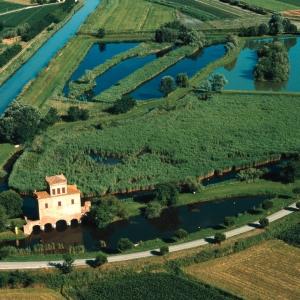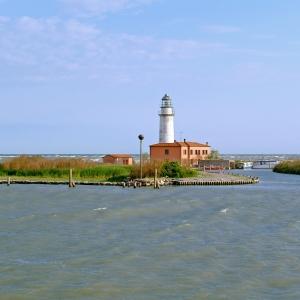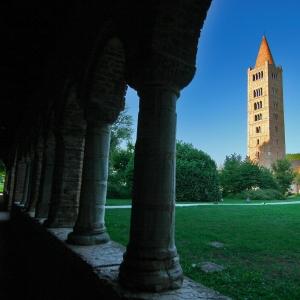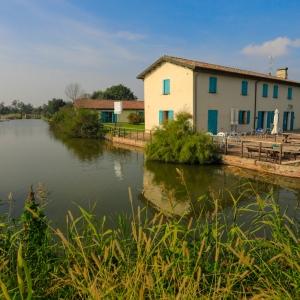FIRST TRIP ITINERARY IDEA - NORTH OF THE PARK
Lowland woods, memories of ancient forests, an ancient and imposing medieval spiritual centre and the disarming beauty of the mouth of the majestic Po river. Our first proposal (three days and two nights) explores the northern surroundings of the Po Delta Park.
1° DAY: RIVA DEL PO - MESOLA
The departure is from the Riva del Po area, a municipality located on the banks of the Great River that is the setting of the events narrated in the famous novel “Il Mulino sul Po” (The Mill on the Po) by Riccardo Bacchelli. We then head towards Mesola and its Great Wood, a fascinating remnant of lowland woodland that extends over more than 1,000 hectares and can easily be visited on foot or by bicycle following the authorised routes that allow us to spot deer and fallow deer. The Este family, during the Renaissance period, loved to hunt in these places, where they built the majestic Mesola Castle, now home to the Deer Museum. A few kilometres from this Delizia is the Boschetto di Santa Giustina (Santa Giustina wood), also known as the Bosco della Fasanara, which with its rich undergrowth extends as far as the impressive Torre Abate, a work of hydraulic engineering by the Este family.
2° DAY: GORO - POMPOSA
The next day starts with the somnolent atmosphere and salty air that characterises the small fishing village of Goro, at the far end of the province of Ferrara and stretching eastwards towards the sea. This important fishing port is the departure point for numerous boats that follow itineraries to discover the natural environment of the delta and descend along the river to the sea, past islands, sandbanks and reed beds, as well as being a privileged place for birdwatching. Particularly striking is the so-called “Scannone di Goro”, better known as the “Isola dell’Amore” (Love Island) a very recent strip of land that emerged as a result of the advancement of the river Po, at the end of which stands the Faro di Goro lighthouse, built in 1950 to replace the 19th-century Lanterna Vecchia and now one of the area's main attractions. It is only a short journey from Goro to Pomposa Abbey; this masterpiece of Romanesque art suddenly appears to the visitor with its soaring bell tower in the green plain, revealing unexpected treasures of art and history. Scattered groups of Benedictine monks decided to start a small community from the 6th-7th centuries A. D., but it was after the year 1000 that the period of greatest splendour began, with the monastery welcoming illustrious figures of the time, including the famous Guido d'Arezzo, the monk who invented musical writing based on the seven-note system. Inside the basilica of Santa Maria is one of the most precious fresco cycles in the province, inspired by Giotto.
3° DAY: CODIGORO - MOUTH OF PO RIVER
Finally, the third and last day of our journey leads us to explore the surroundings of Codigoro, an important agricultural centre in the lower part of the province of Ferrara, whose historical evolution is closely linked to the centuries-long history of land reclamation. The evocative Canneviè Oasis, only a few kilometres from the town centre, is a small brackish valley and ancient valley relict of a larger complex of coastal lagoons that once surrounded Pomposa Abbey. A veritable oasis of tranquillity that can be explored either on foot or by bicycle, including a nature trail equipped for birdwatching. From here, motorboat excursions depart through the impenetrable reed beds to the mouth of the Po di Volano river.






